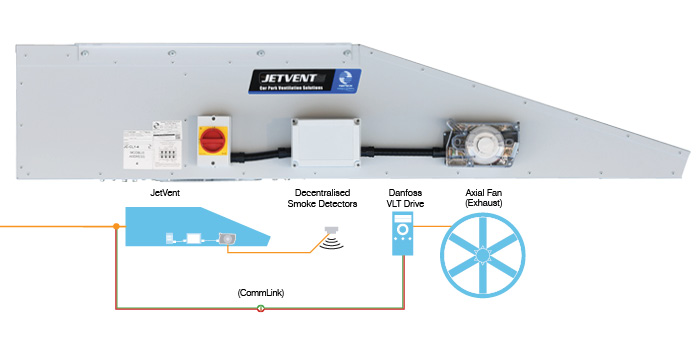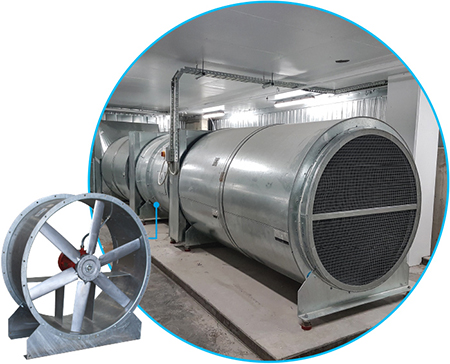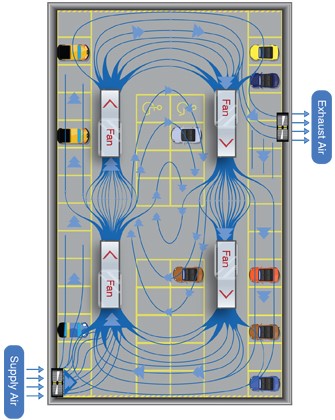Fantech’s JetVent Car Park Ventilation System provides an innovative solution that uses demand control ventilation to help ensure a high standard of air quality whilst minimising energy consumption. It utilises the Fantech’s Aviator controls to digitally connect JetVent fans, Supply & Exhaust fans, Sensors and the Building Management System (BMS) together. This connectivity reduces installation time, capital cost, creates a higher level of system monitoring, seamless control and fast commissioning.
The ventilation of car parks is essential for removing vehicle exhaust fumes containing harmful pollutants. Some of these pollutants include Carbon Monoxide (CO), Nitrogen Dioxides (NO2 ), Sulphur Dioxide (SO2 ) and heavy metal compounds.
The JetVent ventilation system is based on a number of small high velocity JetVent fans that replaces traditional distribution ductwork in closed car parks or increases cross-flow ventilation in open car parks. JetVent is an alternative option for mechanical ventilation, and be used in place of both traditional ducted and non-ducted car park systems.

Fan Specifications
The capacity of a single fan increases with its thrust rating. All JetVent car park fans are rated according to this in Newtons (N) of thrust.
All JetVent Fan types are tested to the following Standards:
Thrust performance based on tests to BS848: Part 10:1999.
Noise data based on tests to BS848: Part 2:1985.
Advantages
Largely eliminates the need for air distribution ductwork within the car park.
The mechanical supply and exhaust systems have less resistance and therefore require smaller fans that consume less power.
Ventilation risers and plant rooms reduce in size and quantity, making the car park more open and possibly yielding additional car park spaces.
Increasing the number of control zones in the car park maybe possible. This can increase the energy efficiency of the system over and above the best ducted car park ventilation systems.
Great potential for reduced excavation and construction costs. System is small in vertical profile and the placement of fans can be very flexible resulting in lower floor-to-ceiling heights.
How it works
JetVent Fans operate on well proven longitudinal tunnel ventilation principles.The fans produce a high velocity jet of air, in turn moving a larger quantityof air surrounding the fan through a process known as entrainment. The amount of air entrained by a single fan increases with the velocity and the quantity of air being discharged by the fan. These characteristics directly relate to the thrust rating of the fan, which is measured in Newtons (N).
Figures 1(a) and 1(b) show the difference in principle between Ducted and JetVent ventilation systems.
Intelligent JetVent Fans
Fantech offers a range of JetVent fans that feature advanced digital EC motor technology with
integrated speed control. It allows precise control of every JetVent and the ability to implement a
system that connects sensors directly to the fans.
The revolutionary feature of this system is ComLink, the digital communication between JetVent
fans, sensors and the pre-configured Fantech Aviator Controller. The result is a very simple control
wiring scheme that is easy to install and commission, while providing a high level of energy
efficiency and system monitoring. The Aviator controller will vary the operating speed of the fans
and therefore the ventilation rate, according to the CO or NO2
pollutant levels in the car park.
The JetVent fan speed is pre-set so it does not operate above the recommended noise level of
65dB(A) @ 8m (AS2107:2000).

Pollutant Monitoring
The innovative Aviator controller monitors pollutant sensors connected to the system and
adjusts the JetVent fan’s operating speed to meet the air quality requirements. Both Carbon
Monoxide (CO) and Nitrogen Dioxide (NO2
) sensors can be connected to the nearest main
Aviator controller, Expansion Module, JetVent fan or Danfoss VLT Drive. These sensors are
typically 4-20mA type or 0-10Vdc type and can be Modbus enabled.
Temperature Monitoring
The Aviator controller can also monitor temperature sensors connected to the system.
if a hot area is identified within the car park such as near an air conditioning condenser.
JetVents fans turn on when demand ventilation is required to reduce the temperature.
These sensors are typically the 4-20mA or 0-10Vdc type and can be Modbus.
Smoke Detection
The Aviator control system can be activated to monitor Fantech smoke detection sensors.
Duct probe smoke detectors can be fitted to the side of each JetVent fan and additional
decentralised smoke detection sensors can be connected to the JetVent fans or Aviator
controller as required. The Aviator controller can also be integrated into a third party smoke
detection system if required.
JetVent Ancillaries
Smoke Detection
Fantech’s Aviator control system comes with optional integrated smoke detection. Smoke detectors
can be fitted as duct probes to the side of each JetVent fan or installed as optional decentralised
detectors that link to the JetVent fans, or controller via ComLink (RS485). Once the smoke detectors
are installed, the Aviator controller will switch to smoke detection mode and continuously monitor the
level of smoke in a car park.
Aviator smoke detection operates as an early warning system should the event of a fire occur in the
car park. The controller will display an alert on its graphic interface, activate warning alarms and flag
the BMS if connected. The JetVent fans will turn off (0%) and the supply and exhaust fans will operate
at full speed (100%) in compliance with AS1668.1. It can also be configured to suit local regulations
or building designs if required. The Aviator controller will continue to monitor the activated smoke
detector, and if cleared it will reset and return to normal car park ventilation mode.
Note (A): Aviator smoke detection must NOT be connected to the Fire Detection Control Indication
Equipment (FDCIE). This is an early detection and shutdown system to ensure the JetVent fans do
not impact the operation of the installed fire detection and suppression system, and minimise the
smoke conditions in the car park.
Note (B): If a third party smoke detection system is used, the Aviator controller can be connected
via its smoke detection input.
Smoke detectors can be factory fitted to the JetVent fans and
installed throughout the car park with a direct network connection to
the JetVent. All smoke detectors are continuously monitored by the
Aviator controller using Modbus RTU system communications and
powered via the jet fan.
Axial Flow Fans
and Attenuators
Fantech’s axial flow fans are available in an extensive
range of sizes and variants to suit both supply or
exhaust applications in car parks. They can be
manufactured as vertical mount for riser installations
and horizontal mount, typically used in plant rooms.
They are available in 13 sizes extending from 315 to
2000mm diameter and can be fitted with matching
rectangular or circular attenuators.
- Casings are made of durable galvanised steel
- Casings of stainless steel, other materials or
special coatings can be supplied
- Axial flow fans can be made with a specific impeller
pitch angle to accurately meet the specification
- Matching attenuators can be supplied to achieve
superior noise reductions in car park applications
System Layouts & Applications
Assisted Natural Flow/Augmented Ducted System
Where supply and exhaust air outlets are
a large distance apart (more than 40m), there
must be provisions to ensure air moves evenly
across the width of the car park.
JetVent Fans can be used to maintain constant
air movement in these car parks to remove
the effects of air stagnation and the resulting
build up of pollutants. In large open car parks,
JetVent Fans can be used to create a large
pressure difference between supply and
exhaust, hence boosting air flow in
and out of the car park as shown below.

Linear flow
A linear flow system uses JetVent Fans
pointing in the same general direction to
move air from one end of a car park to the
other. This system is similar to a traditional
mechanically ducted system. The main
difference is that the JetVent Fans direct air
flow from a single supply point to a single
exhaust point.
For this scheme to work effectively, the
exhaust and supply points should be located
on opposing ends of the car park across its
longest dimensions. If this is not the case,
units arranged for circular mixing may be a
better solution.
Circular mixing
JetVent Fans can be positioned
around the car park to generate
air movement in a circular pattern.
The result is that air gets mixed
and stirred throughout the entire
area, which provides greater
dilution of pollutants within the car
park. This system layout example
shows the direction of air flow from
supply to exhaust.
Circular mixing is suitable for
smaller car parks. This system
also provides added flexibility
when positioning supply and
exhaust points. Unlike a linear flow
system, a circular mixing system
does not require exhaust and
supply points to be on opposite
sides of the car park.










